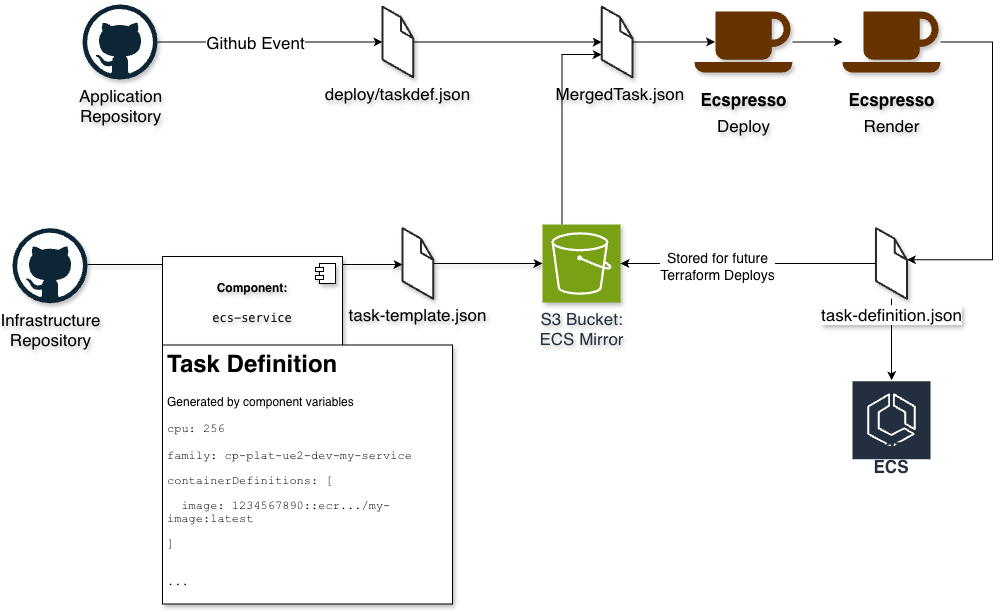ECS Partial Task Definitions
This document describes what partial task definitions are and how we can use them to set up ECS services using Terraform and GitHub Actions.
The Problem
Managing ECS Services is challenging. Ideally, we want our services to be managed by Terraform so everything is living in code. However, we also want to update the task definition via GitOps as through the GitHub release lifecycle. This is challenging because Terraform can create the task definition, but if updated by the application repository, the task definition will be out of sync with the Terraform state.
Managing it entirely through Terraform means we cannot easily update the newly built image by the application repository unless we directly commit to the infrastructure repository, which is not ideal.
Managing it entirely through the application repository means we cannot codify the infrastructure and have to hardcode ARNs, secrets, and other infrastructure-specific configurations.
Introduction
ECS Partial task definitions is the idea of breaking the task definition into smaller parts. This allows for easier management of the task definition and makes it easier to update the task definition.
We do this by setting up Terraform to manage a portion of the task definition, and the application repository to manage another portion.
The Terraform (infrastructure) portion is created first. It will create an ECS Service in ECS, and then upload the task
definition JSON to S3 as task-template.json.The application repository will have a task-definition.json git
controlled, during the development lifecycle, the application repository will download the task definition from S3,
merge the task definitions, then update the ECS Service with the new task definition. Finally, GitHub actions will
update the S3 bucket with the deployed task definition under task-definition.json. If Terraform is planned again, it
will use the new task definition as the base for the next deployment, thus not resetting the image or application
configuration.

Pros
The benefit to using this approach is that we can manage the task definition portion in Terraform with the infrastructure, meaning secrets, volumes, and other ARNs can be managed in Terraform. If a filesystem ID updates we can re-apply Terraform to update the task definition with the new filesystem ID. The application repository can manage the container definitions, environment variables, and other application-specific configurations. This allows developers who are closer to the application to quickly update the environment variables or other configuration.
Cons
The drawback to this approach is that it is more complex than managing the task definition entirely in Terraform or the application repository. It requires more setup and more moving parts. It can be confusing for a developer who is not familiar with the setup to understand how the task definition is being managed and deployed.
This also means that when something goes wrong, it becomes harder to troubleshoot as there are more moving parts.
Getting Setup
Pre-requisites
- Application Repository - Cloud Posse Example ECS Application
- Infrastructure Repository
- ECS Cluster - Cloud Posse Docs - Component.
ecs-service- Cloud Posse Docs - Component.- Must use the Cloud Posse Component.
v1.416.0or later.
- S3 Bucket - Cloud Posse Docs - Component.
Steps
Set up the S3 Bucket that will store the task definition.
This bucket should be in the same account as the ECS Cluster.S3 Bucket Default Definition
components:
terraform:
s3-bucket/defaults:
metadata:
type: abstract
vars:
enabled: true
account_map_tenant_name: core
# Suggested configuration for all buckets
user_enabled: false
acl: "private"
grants: null
force_destroy: false
versioning_enabled: false
allow_encrypted_uploads_only: true
block_public_acls: true
block_public_policy: true
ignore_public_acls: true
restrict_public_buckets: true
allow_ssl_requests_only: true
lifecycle_configuration_rules:
- id: default
enabled: true
abort_incomplete_multipart_upload_days: 90
filter_and:
prefix: ""
tags: {}
# Move to Glacier after 2 years
transition:
- storage_class: GLACIER
days: 730
# Never expire
expiration: {}
# Versioning isnt enabled, but these default values are still required
noncurrent_version_transition:
- storage_class: GLACIER
days: 90
noncurrent_version_expiration: {}import:
- catalog/s3-bucket/defaults
components:
Terraform:
s3-bucket/ecs-tasks-mirror: #NOTE this is the component instance name.
metadata:
component: s3-bucket
inherits:
- s3-bucket/defaults
vars:
enabled: true
name: ecs-tasks-mirrorCreate an ECS Service in Terraform
Set up the ECS Service in Terraform using the [`ecs-service` component](https://github.com/cloudposse/Terraform-aws-components/tree/main/modules/ecs-service). This will create the ECS Service and upload the task definition to the S3 bucket.
To enable Partial Task Definitions, set the variable `s3_mirror_name` to be the component instance name of the bucket to mirror to. For example `s3-bucket/ecs-tasks-mirror`components:
Terraform:
ecs-services/defaults:
metadata:
component: ecs-service
type: abstract
vars:
enabled: true
ecs_cluster_name: "ecs/cluster"
s3_mirror_name: s3-bucket/ecs-tasks-mirrorSet up an Application repository with GitHub workflows.
An example application repository can be found here.
Two things need to be pulled from this repository:- The
task-definition.jsonfile underdeploy/task-definition.json - The GitHub Workflows.
An important note about the GitHub Workflows, in the example repository they all live under
.github/workflows. This is done so development of workflows can be fast, however we recommend moving the shared workflows to a separate repository and calling them from the application repository. The application repository should only contain the workflowsmain-branch.yaml,release.yamlandfeature-branch.yml.
To enable Partial Task Definitions in the workflows, the call to [`cloudposse/github-action-run-ecspresso` (link)](https://github.com/cloudposse-examples/app-on-ecs/blob/main/.github/workflows/workflow-cd-ecspresso.yml#L133-L147) should have the input `mirror_to_s3_bucket` set to the S3 bucket name. the variable `use_partial_taskdefinition` should be set to `'true'`Example GitHub Action Step
- name: Deploy
uses: cloudposse/github-action-deploy-[email protected]
continue-on-error: true
if: ${{ steps.db_migrate.outcome != 'failure' }}
id: deploy
with:
image: ${{ steps.image.outputs.out }}
image-tag: ${{ inputs.tag }}
region: ${{ steps.environment.outputs.region }}
operation: deploy
debug: false
cluster: ${{ steps.environment.outputs.cluster }}
application: ${{ steps.environment.outputs.name }}
taskdef-path: ${{ inputs.path }}
mirror_to_s3_bucket: ${{ steps.environment.outputs.s3-bucket }}
use_partial_taskdefinition: "true"
timeout: 10m- The
Operation
Changes through Terraform will not immediately be reflected in the ECS Service. This is because the task template has
been updated, but whatever was in the task-definition.json file in the S3 bucket will be used for deployment.
To update the ECS Service after updating the Terraform for it, you must deploy through GitHub Actions. This will then
download the new template and create a new updated task-defintion.json to store in s3.